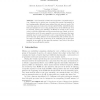Free Online Productivity Tools
i2Speak
i2Symbol
i2OCR
iTex2Img
iWeb2Print
iWeb2Shot
i2Type
iPdf2Split
iPdf2Merge
i2Bopomofo
i2Arabic
i2Style
i2Image
i2PDF
iLatex2Rtf
Sci2ools
DNA
2007
Springer
2007
Springer
Solutions to Computational Problems Through Gene Assembly
Abstract. Gene assembly in ciliates is an impressive computational process. Ciliates have a unique way of storing their genetic information in two fundamentally different forms within their two types of nuclei. Micronuclear genes are broken into blocks (called MDSs), with MDSs shuffled and separated by non-coding material; some of the MDSs may even be inverted. During gene assembly, all MDSs are sorted in the correct order to yield the transcription-able macronuclear gene. Based on the intramolecular model for gene assembly, we prove in this paper that gene assembly may be used in principle to solve computational problems. We prove that any given instance of the hamiltonian path problem may be encoded in a suitable way in the form of an ‘artificial’ gene so that gene assembly is successful on that gene-like pattern if and only if the given problem has an affirmative answer.
DNA 2007 | Gene Assembly | Impressive Computational Process | Transcription-able Macronuclear Gene |
| Added | 07 Jun 2010 |
| Updated | 07 Jun 2010 |
| Type | Conference |
| Year | 2007 |
| Where | DNA |
| Authors | Artiom Alhazov, Ion Petre, Vladimir Rogojin |
Comments (0)

